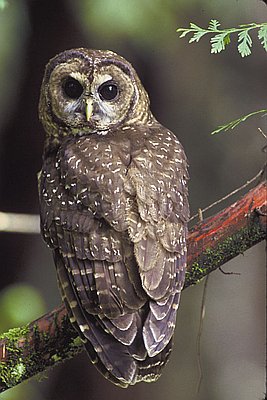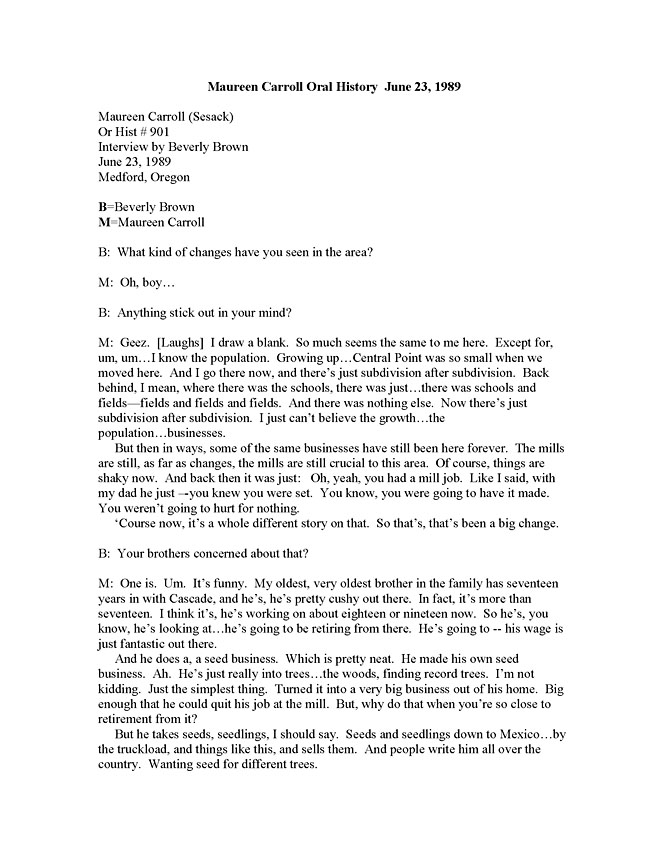- Catalog No. —
- OrHist 901
- Date —
- June 23, 1989
- Era —
- 1981-Present (Recent Oregon History)
- Themes —
- Environment and Natural Resources, Government, Law, and Politics, Labor, Trade, Business, Industry, and the Economy, Women
- Credits —
- Oregon Historical Society
- Regions —
- Southwest
- Author —
- Beverly Brown
Maureen Carroll's Oral History
Beverly Brown interviewed Maureen Carroll of Central Point, Oregon in 1989 as part of a larger effort to document and interpret the experiences of “working people” in the woods of Southern Oregon. In this excerpt of her interviw, Ms. Carroll reflects on the changes confronting Central Point during the spotted owl conflict, when its timber-based economy began a transition into an economy based on shopping and tourism.
By the 1980s, “old-growth” forest habitat had become increasingly scarce throughout Southern Oregon and the Pacific Northwest. Consequently, the population of northern spotted owls (Strix occidentalis caurina), whose survival is dependent upon old-growth habitat, slid dangerously toward extinction. Environmentalists reacted by demanding that the U.S. Forest Service devise a plan to protect the owl from the damaging effects of the industrial logging of the region’s remaining old-growth forests. The environmentalists also petitioned the U.S. Fish and Wildlife Service to add the spotted owl to the “endangered species list,” to safeguard its survival.
The timber industry responded claiming that the owls had been undercounted and were not endangered and claimed the spotted owl crisis was a hoax perpetrated by urban environmentalists bent on “locking up” valuable old-growth timber at the expense of rural logging communities. The industry succeeded in focusing the fears of many loggers, truckers, and mill workers against the spotted owls themselves. “Save a logger—eat an owl!” became a slogan commonly seen across the Pacific Northwest. As a result, many spotted owls were purposely killed until professional foresters spoke out about the root causes for the mass lay-offs and mill closures, namely the unsustainable harvesting of forests and a high volume of “raw” or “minimally processed” logs being sent to Southeast Asia. Just as important, the process of bidding for timber sales on public lands disadvantaged small companies not able to compete with large diversified corporations, who were able to outbid them on most sales, forcing their smaller competitors out of business.
In 1987, the Fish and Wildlife Service determined that the owls were not at risk of extinction and were not eligible for protection under the Endangered Species Act. However, in 1988, a judge ruled that the Service’s decision to not list the owl was “arbitrary” and ignored the recommendations of its own scientists. Finally, in June of 1989, the Fish and Wildlife Service added the northern spotted owl to the endangered species list as a “threatened” species defined as “any species which is likely to become an endangered species within the foreseeable future throughout all or a significant portion of its range.” As of 2004, spotted owl populations have continued to decline.
Further Reading:
Brown, Beverly. In Timber Country: Working People's Stories of Environmental Conflict and Urban Flight. Philadelphia, Pa, 1995.
Hirt, Paul. A Conspiracy of Optimism: Management of the National Forests Since World War Two. Lincoln, Nebr., 1994.
Written by Joshua Binus, © Oregon Historical Society, 2003.
Related Historical Records
-
Making a Timber Industry
In 1905, the business of logging had an entire building to celebrate its development. The Forestry Building was Oregon’s unique contribution to the architecture of world’s fairs. It …
-
Northern Spotted Owl
This photograph was taken by a U.S. Fish and Wildlife photographer around 2002. It shows a northern spotted owl (Strix occidentalis caurina) perched on a tree branch in …

-
Restructuring the Timber Economy
In October 1979, the bottom fell out of the wood-products market. Over the next three years, lumber prices dropped by more than 48 percent. The national recession of …
